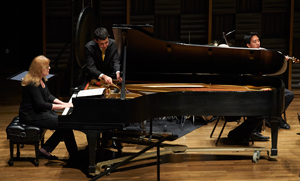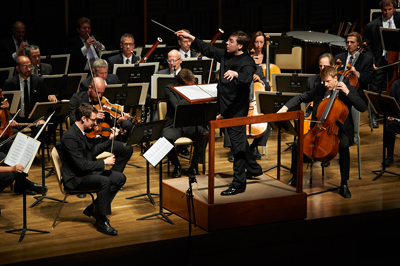by Mike Telin & Daniel Hathaway
“Go West, young man, go West,” was the much quoted advice probably misattributed to Horace Greeley, and for many during the Westward Expansion, the ultimate destination was California.
Last week, in their second collaboration in Gartner Auditorium, The Cleveland Orchestra and the Cleveland Museum of Art’s VIVA! & Gala Performing Arts Series presented “California Masterworks”, a two-concert series that drew on six seminal works by Henry Cowell, Dane Rudhyar, Lou Harrison, John Adams, James Tenney and Terry Riley to create a retrospective of music created by Californians — either born or raised there (Cowell, Harrison and Riley) or moved there to spend extended periods of time (Adams, Rudhyar and Tenney) but all of whom are linked by “common threads — different threads”, “bumping the classical tradition slightly off its axis” and offering “not so much a glimpse of the fringe as of the future,” as the Museum’s Tom Welch wrote in his extensive introduction in the program book.
“What is California?” Tom Welch asks. “In our national mythology it is the land of discovery, renewal, and constant reinvention…Ever since the Gold Rush it is the land of dreamers and doers.” That theme was reinforced in two pre-concert illustrated lectures by Case art history professor Henry Adams, who talked about “The Quest for Nirvana and the Birth of Modern Art” (the influence of Zen Buddhism on John Cage and, in turn, on such visual artists as Robert Rauschenberg) on Wednesday and used eccentric domestic architecture (William Randolph Hearst’s castle in San Simeon, Robinson Jeffers’s Tor House in Carmel and Frank Gehry’s house renovation in Santa Monica) to illustrate “The Funkiness of California Art in the 20th Century” on Friday. Pithy in-concert remarks were provided by NewMusicBox senior editor Frank J. Oteri.
On Wednesday evening, May 1, James Feddeck led half of The Cleveland Orchestra (the other half were at Severance Hall presenting concerts with Ton Koopman) in Cowell’s 1928 Sinfonietta, Rudhyar’s 1982 Out of the Darkness — syntonic drama in five acts and Harrison’s 1974 Suite for Violin with String Orchestra (originally for violin and gamelan) with principal second violinist Stephen Rose as soloist.
On Friday evening, the menu included Adams’s 1978 Shaker Loops, Tenney’s 1972 Clang and Riley’s 1990 The Sands, featuring the Calder Quartet (Benjamin Jacobson and Andrew Bulbrook, violins, Jonathan Moerschel, viola & Eric Byers, cello) — an ensemble itself born in California.
With pieces ranging in date of composition from 1928 to 1990 — and three dating from the 1970s — a variety of influences and styles were in evidence. Cowell set out to explore unresolved dissonance; Rudhyar, as much of a writer as a musician (he was Elvis Presley’s astrologist as well), was interested in the movement from darkness into light, from trial to transmutation; and Harrison was interested in multiculturalism, leading him to develop his violin suite with its soloist Lorin Jakey and his partner Bill Colvig for the “American” Gamelan (it was performed on Wednesday in a 1993 arrangement for string orchestra with piano, celesta and two harps).
Adams, a transplanted New Englander, turned to minimalism as a way out of his compositional doldrums for Shaker Loops (named for the twitchy dancing of the religious sect who had lived in his home state of New Hampshire); Tenney turned to aleatoric (chance) techniques to explore the ramifications of the harmonic series generated by a single note, producing in Clang a work that will never be quite the same from performance to performance (Feddeck held up fingers to signal events); and Riley, who was in at the beginning of the minimalist movement, generated Sands for the Kronos Quartet out of outrage at the invasion of Iraq — at least for the first two movements before the musical inspiration becomes omnivorous in RubberLady’s Theme Music and Ebony Horns.

On Wednesday, Lou Harrison’s inventive Suite was stunning on every level. Though its non-Western sounds may now be commonplace, it must have made a significant impression on the ears of listeners in 1974. Violin soloist Stephen Rose exhibited amazing control, especially in the first movement cadenza. The Estampie included slaps on the bodies of cellos and basses. The final Chaconne was otherworldly. Earlier, Cowell’s chamber-sized Sinfonietta gave interesting parts to every player, especially cellist Richard Weiss, who was outstanding.
Though Tenney’s Clang was arresting on Friday for its waves of sound punctuated at beginning, middle and end with bell strokes, Riley’s Sands, though overly long in some of its parts, grabbed attention for its wildly syncopated rhythms, its third-movement cello solo and foxtrot and the cheerful, Ghanaian rhythms of its finale (photo above: percussionist Mark Demoulakis sharing the piano strings with Joela Jones). The Calder Quartet were thrilling ensemble soloists.
Perhaps through overexposure (because of its scoring, it’s one of his more economical works to perform), Adams’s Shaker Loops seemed prolix and tedious though the strings were precise and tireless. Rudhyar’s “syntonic drama,” composed in 1982 but only now receiving its premiere after the composer’s death in 1985, sounded amateurish.
“California Masterworks” was intriguing but left you wondering about some missing persons. Where was Schoenberg and who demonstrated his influences? He spent the last part of his life in L.A. and taught both Lou Harrison and John Cage; his Viennese student Alban Berg taught Henry Cowell, who shows his debt to the Second Viennese School in his Sinfonietta. And Stravinsky? And Rachmaninoff? And Schoenberg’s tennis partner, George Gershwin? There may be more of an interesting back story here than the series took into consideration.
After Friday’s concert, the audience was invited to adjourn to the Atrium to witness John Cage’s HSPCHD (pronounced “harpsichord”), written with Lejaren Hiller in 1969. Announced as “an immersive performance/sound environment for up to seven amplified harpsichords, electronic sounds and projections”, the performance centered around five instruments from the Museum’s and Orchestra’s collections played by seven harpsichordists splayed in star formation on a dais (two spare players were waiting to relieve the original five). Projections of abstract images changed constantly overhead.
The harpsichordists made an agreeable, chaotic jangle as they played from Cage’s composed score or, when directed, their own favorite Mozart pieces, interrupted at intervals by electronic sounds and conversation from the circling audience fueled by cocktails, wine and beer. It was a happening. It was fun. And by a truly cosmic coincidence, the piece was being played in New York at the same hour. But the New Yorkers could only muster three harpsichords for the occasion.
Photos by Roger Mastroianni courtesy of The Cleveland Orchestra.
Published on ClevelandClassical.com May 9, 2013
Click here for a printable version of this article.



